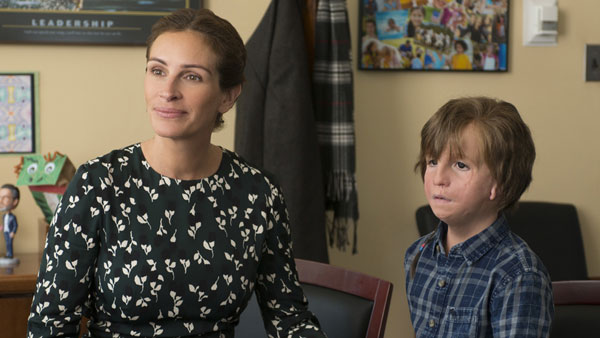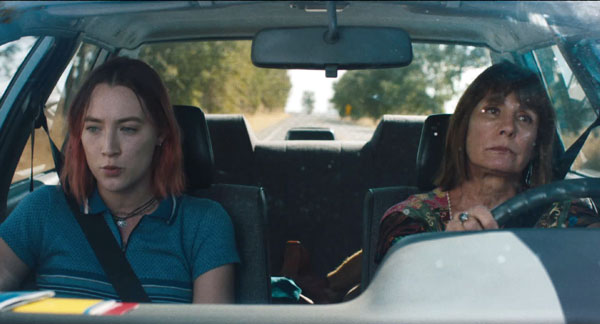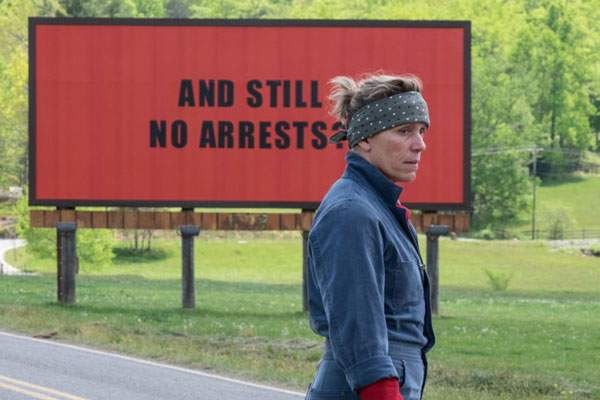|
Misunderstandings—the inability to understand another’s thoughts or actions--are the crux of much literature and drama. Everything from Shakespeare to sitcoms is unthinkable without them. Misunderstandings abound in four excellent movies released toward the end of 2017; the difference between them lies in the characters involved and the issues at stake.
The gentlest of these movies is Stephen Chbosky’s Wonder,based on the novel by R.J. Palacio. The screenplay by Chbosky, Jack Thorne and Steve Conrad tells the story of Auggie Pullman (Jacob Tremblay), a fifth-grade boy in Manhattan who was born with a severe medical condition. Needing twenty-seven operations merely to survive, Auggie is left with a permanently deformed face, to the point that he has taken to wearing a space helmet almost everywhere he goes.
At the film’s beginning, Auggie’s parents Isabel (Julia Roberts) and Nate (Owen Wilson), who have home-schooled him up to now, are enrolling him in a regular school for the first time. Abandoning the helmet, Auggie is subject to the predictable bullying and ostracism, but he also meets and befriends a classmate named Jack Will (Noah Jupe). Everything goes fine until the school’s Halloween party, when Auggie, disguised in a GhostFace costume, overhears Jack dissing him to the school bully Julian (Bryce Gheisar).
 |
The happy surprise of Wonder is that Auggie is the film’s center, but not its sole focus. Wonder is not an “Illness of the Week” movie, but a touching and sensitive exploration of the delicacy of young people’s feelings, and how easily misunderstandings can arise among them. Chbosky shifts the focus deftly to other characters, as needed. Jack Will has his say; so does Via (Izabela Vidovic), Auggie’s older sister, who feels neglected because of her parents’ concentration on Auggie. Via does not understand why her former best friend Miranda (Danielle Rose Russell) is shunning her; soon enough, we hear why, from Miranda herself. Even Julian comes in for sympathy; his parents, it turns out, are the true villains of Wonder, underscoring the desperate need children have for parental guidance.
All of these performers are as fine as they can be, as are Mandy Patinkin as Mr. Tushman and Daveed Diggs as Mr. Browne, the principal and teacher everybody wishes they had. It sounds like a cliché to say the story reaches catharsis with a school production of Our Town, but in Chbosky’s hands that ending is quite satisfying.
Wonder was the breakout hit of the Christmas season, and deservedly so. It is perfect for the middle-school and teenage audience it’s designed for, and also provides warmth, poignancy and believable characters for older viewers. The film’s moral is summed up by what Mr. Browne tells his class: “If you have a choice between being right and being kind, choose kind.”
Kindness is also in evidence in Greta Gerwig’s Lady Bird, though mitigated heavily with strife. Any movie that begins with one of the main characters throwing herself out of a moving car cannot precisely be called “gentle.”
In Gerwig’s semi-autobiographical screenplay, Christine “Lady Bird” McPherson (Saoirse Ronan) and her mother Marion (Laurie Metcalf) are constantly at each other’s throats. Living in Sacramento in the early 2000s, Lady Bird rejects her surroundings, even her given name. “Yes, Lady Bird is my given name,” she says when asked. “It is the name I gave myself.”
Lady Bird tells the story of its eponymous character’s senior year at a Catholic high school. Lady Bird desperately wants to be anywhere except Sacramento, preferably at a college in the East, even though Marion and Sister Sarah Joan (Lois Smith), her faculty adviser, point out that she doesn’t have the grades for a scholarship or the money to pay for tuition. Larry (Tracy Letts), her gentle, retiring father, encourages Lady Bird but can offer little help: his job at an aerospace company is hanging by a thread.
Lady Bird knows she wants more out of life than she’s getting, but doesn’t quite know what it is she wants. She tries out for the class play; she tries to enter the cool clique in her high school, forsaking her BFF Julie (Beanie Feldstein) in the process. She has fumbling relationships in succession with two classmates: Danny (Lucas Hedges), a shy young actor, and Kyle (Timothee Chalamet), an arrogant young rock musician. Meanwhile, Marion simply doesn’t understand why Lady Bird isn’t content with what she’s got. Above all, she wants Lady Bird to be safe; the main reason she sent her to Catholic school was because her adopted brother Miguel (Jordan Hernandez) saw a boy knifed at his public school.
 |
Frankly, Lady Bird is a pain in the ass, but she is also deeply sympathetic. You definitely see the Gerwig persona (perfected in such films as Frances Ha) in Lady Bird, to the point—as one critic pointed out—that sometimes you see Gerwig on screen instead of Saoirse Ronan. This is a tribute to Ronan, who once again proves herself one of the greatest actresses of her generation. The entire cast shines, but the scenes between Ronan and Metcalf are so real, so funny-sad, and so painful that you weep for both of them. There is no truce between them, even at film’s end, but the love between them is palpable.
Lady Bird has come in for some accusations of plagiarism, especially in the case of Real Women Have Curves, Patricia Cardoso’s 2002 film starring America Ferrera and the late Lupe Ontiveros as a mother and daughter at odds. There are strong similarities between the two films—especially the parts about the two young women wanting to go to college in New York against their mothers’ wishes—as well as significant differences. I can only say that both films are funny, touching, beautifully acted, and well worth seeing. Real Women Have Curves is readily available from Netflix and on DVD.
I don’t think anyone will ever accuse Martin McDonagh of plagiarism for Three Billboards Outside Ebbing, Missouri, simply because no one else could have thought of it. Misunderstandings reach a bloody apex in Three Billboards, which features McDonagh’s trademark combination of over-the-top mayhem and deep sympathy for his characters.
At the film’s beginning, Mildred Hayes (Frances McDormand) is in deep mourning for her daughter Angela, who was raped and murdered several months before. Bill Willoughby (Woody Harrelson), police chief in Ebbing, has not found any suspects, explaining to Mildred that the DNA at the scene does not match any samples in the national database. Disgusted, Mildred goes to local advertising man Red Welby (Caleb Landry Jones) and rents three billboards just outside of town. “Raped While Dying/And Still No Arrests/How Come, Chief Willoughby?” is the message Mildred orders to be placed on the billboards.
 |
The billboards arouse the ire of Chief Willoughby, and even more that of one of his deputies, Jason Dixon (Sam Rockwell). A drunken racist infamous for his violence against suspects, Jason has only one redeeming quality—his loyalty to Chief Willoughby. Mildred’s billboard campaign tests Jason’s loyalty to the limit, especially after Chief Willoughby—no fair saying how—is suddenly taken out of the picture.
From this point, Three Billboards becomes the story of the escalating feud between Mildred and Jason, resulting in acts of arson and severe injuries for major characters. However, as is typical with McDonagh, that’s not the story’s end. He adds a (relatively) quiet coda in which Mildred and Jason actually become allies of sorts. Again, no fair saying how this happens.
McDonagh’s movies and plays tend to beguile and repel audiences in equal measure, and Three Billboards may be the most extreme example so far. The film makes you jittery in ways that aren’t entirely enjoyable, and which the coda doesn’t entirely assuage. However, the excellence of the acting can’t be denied, especially that of McDormand and Rockwell. McDormand, one of the most reliably brilliant performers around today, plays Mildred as a tough, disillusioned woman who has suffered a lifetime of sorrow, and who is hellbent on getting justice this time, even if she has to burn down the town. Rockwell, in the best role of his career, presents Jason as a toxic jerk who gradually realizes he’s a better, smarter person than he ever imagined. There also are fine performances by Harrelson, Jones, John Hawkes as Mildred’s ex
-husband, Lucas Hedges as her son, and Peter Dinklage as a local who takes a fancy to Mildred.
Three Billboards can only be recommended to fans of the very darkest black comedy, but its acting alone makes it one of the year’s notable films.
Bharat Nailuri’s The Man Who Invented Christmas was undeservedly ignored by critics and the public when it premiered in November. The story of how Charles Dickens (Dan Stevens) came to write A Christmas Carol, it deserves to become a holiday perennial.
Written by Susan Coyne of Slings & Arrows fame, The Man Who Invented Christmas is set in late 1843. Dickens, at 31 already the most famous author in the English-speaking world, is at loose ends. His last three books were failures, and his expenses are growing exponentially between house renovations, his rapidly growing family and the improvidence of his father, John Dickens (Jonathan Pryce).
Dickens needs a best-seller, and he needs it fast. To the confusion of his agent and publishers, he decides to write a Christmas story. His publishers protest: at the time, Christmas was a relatively minor holiday in England, and they don’t see how he can expect a success with a Christmas story. But Dickens—noticing that Queen Victoria and Prince Albert are planning a big Christmas celebration, as is traditional in Albert’s native Germany—thinks he can ride the crest of that wave.
The bulk of the story is about how Dickens comes to conceptualize and write the book. Dickens’ renowned ability to imagine and act out all his characters, as if they were real and standing before him, comes to the fore. The beloved characters all come tumbling out: Bob Cratchit, Marley’s Ghost, Fezziwig, the Ghost of Christmas Past, and—of course—Scrooge (Christopher Plummer).
However, toward the end, Dickens finds himself unable to complete the book. Much of the problem is tension within the Dickens household, especially Dickens’ fraught relationship with his father. The story builds to a scene between Dickens and Scrooge in the dismal ruins of the Warren’s Blacking factory, in which Dickens must finally confront the fears and resentments that are keeping him from finishing his masterwork.
The Man Who Invented Christmas cannily plays on a tendency well documented in biographies of Dickens: his need to create not only fictional characters, but the real people in his life. When friends and family failed to act in the way he expected, he was dumbfounded. Nailuri and Coyne create a happy ending for Dickens, not only in his creating a masterpiece but in his finally accepting his father, his wife and others for who and what they were.
If Dickens ever actually reached that epiphany, it didn’t last. (Claire Tomalin’s book, The Invisible Woman, and Ralph Fiennes’ film of that book illustrate the perils of Dickens’ later life.) However, The Man Who Invented Christmas ends on a joyous note, and stands as a just tribute to one of the most generous creative minds that ever existed. The cast is excellent. Dan Stevens plays Dickens with gusto and a beguiling madness, while Jonathan Pryce gives John Dickens a Micawber-like charm and poignancy. Christopher Plummer brings a grim, wry formality to Scrooge, leaving the character’s reclamation to be played offstage. Among the featured players, Anna Murphy is notable as Tara, a sweet-natured Irish maid who helps Dickens formulate his characters.
The Man Who Invented Christmas deserves to be played in future double bills with any of the many film versions of A Christmas Carol (my own favorite is the version starring George C. Scott). But it also can stand alone as a delightful Christmas movie all by itself.
|